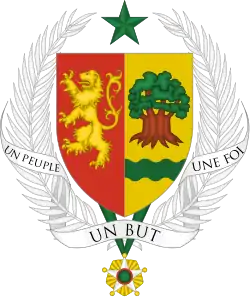Regions of Senegal
Senegal is subdivided into 14 regions (French: régions, singular – région), each of which is administered by a Conseil Régional (pl.: Conseils Régionaux) elected by population weight at the arrondissement level. Senegal is further subdivided into 45 departments, 103 arrondissements (neither of which have administrative function) and by collectivités locales (the 14 regions, 110 communes, and 320 communautés rurales) which elect administrative officers.[1] Three of these regions were created on 10 September 2008, when Kaffrine Region was split from Kaolack, Kédougou region was split from Tambacounda, and Sédhiou region was split from Kolda.

Regions of Senegal
 |
|---|
| This article is part of a series on the politics and government of Senegal |
|
|
To date, all regions take their name from their regional capitals.
| Region | Capital | Area (km2) |
Population (2013 census) [2] |
|---|---|---|---|
| Dakar | Dakar | 547 | 3,137,196 |
| Ziguinchor | Ziguinchor | 7,352 | 549,151 |
| Diourbel | Diourbel | 4,824 | 1,497,455 |
| Saint-Louis | Saint-Louis | 19,241 | 908,942 |
| Tambacounda | Tambacounda | 42,364 | 681,310 |
| Kaolack | Kaolack | 5,357 | 960,875 |
| Thiès | Thiès | 6,670 | 1,788,864 |
| Louga | Louga | 24,889 | 874,193 |
| Fatick | Fatick | 6,849 | 835,352 |
| Kolda | Kolda | 13,771 | 714,392 |
| Matam | Matam | 29,445 | 562,539 |
| Kaffrine | Kaffrine | 11,262 | 566,992 |
| Kédougou | Kédougou | 16,800 | 152,357 |
| Sédhiou | Sédhiou | 7,341 | 452,944 |

The Conseil Régional building in Ziguinchor. Regions, unlike Departments or Arrondissements (but like Communes), have defined administrative and political power in Senegal.
See also
References
- List of current local elected officials Archived 2007-08-19 at the Wayback Machine from Union des Associations d’ Elus Locaux (UAEL) du Sénégal. See also the law creating current local government structures: (in French)Code des collectivités locales, Loi n° 96-06 du 22 mars 1996.
- Senegal Archived 2015-04-19 at the Wayback Machine at GeoHive.
External links
- (in French)List of administrative divisions in Senegal
- (in French)Collectivités locales from Republic of Senegal Government site, l'Agence de l'informatique de l'État (ADIE).
- (in French)Map of main subdivisions and more detailed maps on subdivisions
- (in French)Décret fixant le ressort territorial et le chef lieu des régions et des départements, décret n°2002-166 du 21 février 2002.
- (in French)Code des collectivités locales, Loi n° 96-06 du 22 mars 1996.
This article is issued from Wikipedia. The text is licensed under Creative Commons - Attribution - Sharealike. Additional terms may apply for the media files.